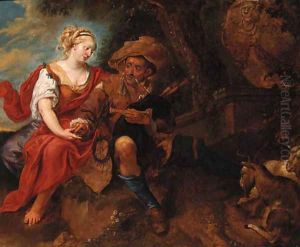Jan Thomas Van Ypren Paintings
Jan Thomas van Yperen, also known as Jan Thomas, was a Flemish Baroque painter and engraver, born in 1617 in Ypres, a city in present-day Belgium. His early life is not well documented, but it is known that he apprenticed under a local artist before moving to Italy to further his studies and career. In Italy, Jan Thomas worked in the vibrant artistic atmosphere of Rome and was influenced by the Italian Baroque style, which was characterized by dramatic effects of light and shadow, rich colors, and dynamic compositions.
During his time in Italy, Jan Thomas came into contact with many influential artists and patrons. He worked for Cardinal Girolamo Farnese in Rome and later entered the service of Archduke Leopold Wilhelm of Austria, who was a prominent collector and patron of the arts. Thomas' work for the Archduke took him to Vienna, where he became a court painter. His style evolved to include the grandeur and pomp characteristic of court art, and he produced portraits, religious works, and allegorical scenes.
Jan Thomas' work was marked by a combination of Flemish realism and Italianate baroque elements. His paintings often featured a strong use of chiaroscuro, the technique of using stark contrasts between light and dark to achieve a sense of volume and depth. He also had a penchant for rich color palettes and sumptuous details, which reflected the opulence of the Habsburg court.
Thomas enjoyed considerable success during his lifetime, receiving commissions from aristocracy and the church. However, after his death in 1678, his fame waned, and he was largely forgotten until art historians began to reassess the Baroque period and its artists. Today, Jan Thomas van Yperen's works can be found in various museums and collections, where they are appreciated for their contribution to the Baroque movement in Flemish art.
